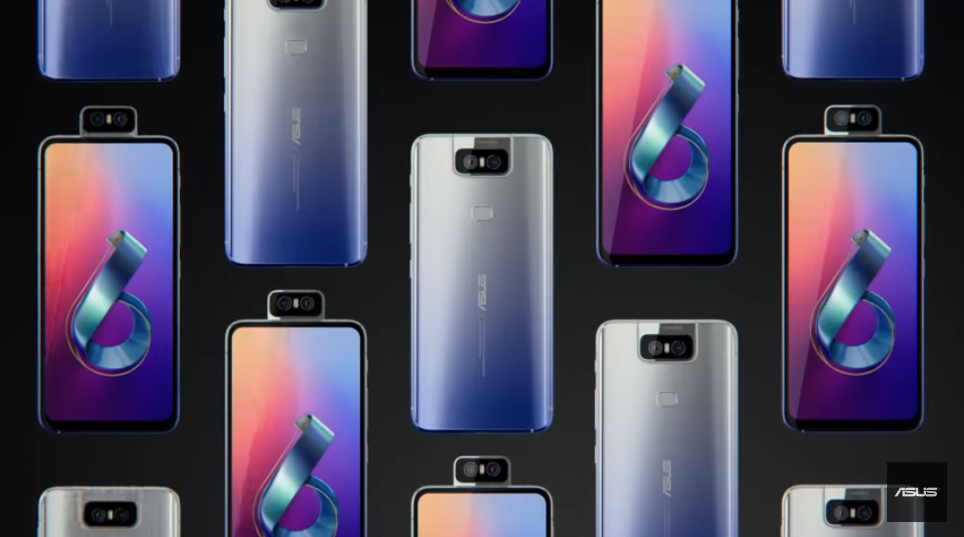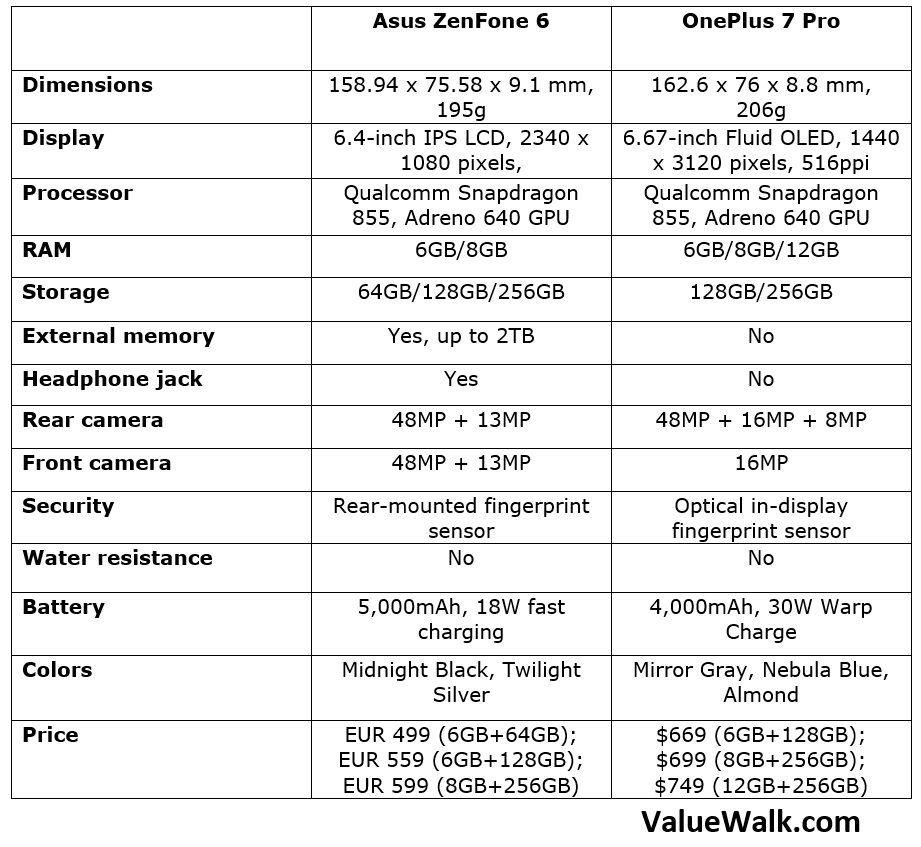At an event in Spain, Taiwanese smartphone vendor Asus unveiled its ZenFone 6 smartphone. The device brings a better camera, improved design, bigger battery, and faster software – all at an affordable price tag. In fact, Asus is one of the rare vendors (or the only?) that haven’t raised the prices of their new flagship models. The Asus ZenFone 6 aims to compete with the newly launched OnePlus 7 Pro in terms of pricing and performance. Let’s check out how the ZenFone 6 stacks up against OnePlus 7 Pro.
Asus ZenFone 6 vs OnePlus 7 Pro: Design
Both the devices have a notch-less and nearly bezel-less design. The ZenFone 6 has a thin but noticeable chin at the bottom. Its rear panel gets fancy gradient colors and has a vertical Asus logo. The back panel is curved on the sides to make it easier for users to hold the phone in hand. The phone has a rear-mounted fingerprint sensor rather than an in-display fingerprint reader.
The ZenFone 6 has a dual camera setup on the back, which also serves as the selfie camera, thanks to the Flip Camera mechanism. The Flip Camera module is made of Liquid Metal and eliminates the need for the display notch. Whenever you need to take a selfie or make video calls, the rear cameras flip around to the front. The Flip Camera module houses two cameras, various sensors, and the earpiece.
The Flip Camera will retract itself automatically in case you drop the phone. It also offers free angle control, meaning you can control the amount of camera rotation. You can stop it midway to capture photos at different angles. Asus claims to have tested the Flip Camera module for 100,000 flips.
The device comes in Midnight Black and Twilight Silver colors. It has dual speakers, a USB-C port, and the 3.5mm headphone jack. Both OnePlus 7 Pro and ZenFone 6 get stereo speakers to enhance the audio experience. But both of them lack an IP rating for water resistance.
The ZenFone 6 measures 158.94 x 75.58 x 9.1 mm and weighs 195g. Its front and rear glass panels are supported by a series 6000 aluminum frame in the middle. Asus has added a Smart Key, which you can use to activate Google Assistant. Users can also customize the Smart Key to launch other apps and perform different functions.
The OnePlus 7 Pro has managed to avoid the display notch by using a pop-up selfie camera mechanism. OnePlus’ pop-up module can also retract itself in the event you accidentally drop the phone. Its front and rear panels both are curved on the sides, giving it a more premium feel. It has a metal frame in the middle.
The OnePlus 7 Pro is larger, wider, and heavier than its rival. It measures 162.6 x 76 x 8.8 mm and weighs 206g. Unlike ZenFone 6, it lacks the 3.5mm headphone jack. The rear panel of both handsets is protected by Corning’s Gorilla Glass. OnePlus has launched the 7 Pro in Nebula Blue, Almond, and Mirror Gray colors.
OnePlus has used an optical in-display fingerprint sensor, which is incredibly fast and convenient. The company has increased the fingerprint sensing area on the 7 Pro to make it easier for you to unlock the device.
Asus ZenFone 6 vs OnePlus 7 Pro: Display
This is where you’ll notice a major difference between the two handsets. The OnePlus 7 Pro features a superior OLED display, which offers more vibrant colors than the LCD screen on ZenFone 6. The OnePlus 7 Pro also offers a faster 90Hz refresh rate, which makes for a smoother and faster gaming experience. The ZenFone 6 has a traditional 60Hz refresh rate.
The ZenFone 6 sports a 6.4-inch IPS LCD screen with Full HD+ resolution of 1080 x 2340 pixels. It has a 19.5:9 aspect ratio, 600 nits of peak brightness, and 92% screen-to-body ratio. The screen is flat, meaning there is no notch or curved corners. Its display is protected by Corning’s Gorilla Glass 6.
The OnePlus 7 Pro has received the highest rating from the testing firm DisplayMate. It sports a 6.67-inch Fluid AMOLED display with Quad HD resolution of 1440 x 3120 pixels. It has a 19.5:9 aspect ratio and 516ppi of pixel density.
Internal specs
Both handsets are powered by the same octa-core Qualcomm Snapdragon 855 chipset and Adreno 640 graphics processor. The Asus ZenFone 6 comes in three different RAM and storage options: 6GB RAM with 64GB storage, 6GB RAM with 128GB storage, and 8GB RAM with 256GB storage.
The Asus device has a dedicated microSD card slot that supports up to 2TB of external storage to ensure that you never run out of storage. Asus has used UFS 2.1 technology for inbuilt memory. In contrast, the OnePlus 7 Pro has the latest and faster UFS 3.0 storage. However, OnePlus 7 Pro lacks the microSD card slot for external memory.
The OnePlus flagship packs 6GB RAM and 128GB storage for the base model. The Chinese company has also launched an 8GB RAM version with 256GB storage and a 12GB RAM model with 256GB storage. It doesn’t support external memory, so you would want to buy the highest storage option you can afford.
Battery
The Asus ZenFone 6 packs a monstrous 5,000mAh battery with support for Quick Charge 4.0 technology. The battery should easily last more than a day of normal-to-heavy usage. It offers 18W fast charging. Asus says it also extends the battery longevity because the phone goes through fewer charging cycles.
Both OnePlus 7 Pro and ZenFone 6 lack wireless charging. The OnePlus 7 Pro sports a 4,000mAh battery with the blazing fast Warp Charge 30 charging technology. Its larger display, the pop-up selfie camera mechanism, and the faster 90Hz refresh rate would consume a lot of power. But the battery should get you through a full day.
Software
Both handsets run the latest Android 9 Pie with a custom skin on top. The ZenFone 6 has Zen UI 6 on top while OnePlus 7 Pro gets the OxygenOS 9.5 skin. Asus has dramatically revamped the Zen UI 6 to offer a fast, clean, and smooth user experience. It is as close to the stock Android experience as Zen UI could get. It brings faster launch times, speed improvements, and better memory management.
The Zen UI 6 brings some of its own goodies such as a system-wide Dark Mode. Asus has promised to upgrade the software to Android Q and then to Android R in the future. The phone will also get at least two years of security patches.
The OxygenOS 9.5 on OnePlus 7 Pro is also pretty close to the stock Android experience. It also has features like Smart Boost and Gaming Mode to deliver better performance while preserving battery life. The OxygenOS also brings background optimization to keep the phones running fast even when they get older. OnePlus is well known for offering timely software updates and security patches.
Camera
During the unveiling event, Asus talked at great lengths about the Flip Camera module on the ZenFone 6. The camera module uses a stepper motor to rotate depending on whether you want to use the main camera or want to take selfies.
The ZenFone 6 sports a 48-megapixel primary lens with f/1.8 aperture and dual LED flash. It is accompanied by a 13-megapixel ultra-wide angle lens with a 125-degree field of view. The same setup serves as the front camera as well. It is capable of recording 4K videos at 60fps with EIS. It also get the Night Mode and HDR+ Enhanced mode to offer better image quality.
The OnePlus 7 Pro has a triple camera setup on the back. It consists of a 48-megapixel main camera with f/1.6 aperture and OIS; a 16-megapixel ultra-wide angle lens with 117-degree field of view and f/2.2 aperture; and an 8-megapixel telephoto sensor with f/2.2 aperture, OIS, and 3x optical zoom. Just like ZenFone 6, it can record 4K videos at 60fps.
For selfies, the OnePlus 7 Pro features a 16MP pop-up camera that comes up whenever needed.
Asus ZenFone 6 vs OnePlus 7 Pro: Price
Asus has started accepting pre-orders for the ZenFone 6 in European markets via its website. The device starts at EUR 499 for the base model with 6GB RAM and 64GB storage. The 6GB+128GB version costs EUR 559 while the top-end 8GB+256GB has been priced at EUR 599. The company will start shipping the device on May 25th.
The OnePlus 7 Pro is more expensive than the ZenFone 6. It starts at $669 for the 6GB+128GB version. The 8GB+256GB model costs $699 while the top-end 12GB+256GB variant is going to set you back by $749.
For the additional price, the OnePlus 7 Pro gets you a better display and a triple camera system. The ZenFone 6 is relatively cheaper but offers similar specs plus the 3.5mm audio jack and a microSD card slot. It appears to be a worthy alternative to the OnePlus flagship.













